Metallurgy in Tuscany

For millennia, the fortunes of Tuscany have been tied to the extraction of the minerals that the territory offered in generous supply. Iron, in particular, was the object of systematic exploitation since antiquity, accompanied by an increasingly greater rationalisation of working processes. When Italy’s wartime needs required iron, it was precisely the thousands of tuns of iron scoria that covered the necropoli of Populonia which supplied the precious metal for the cannons and guns of soldiers during World War I.
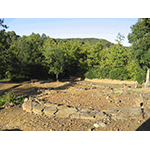
The Etruscan Age - The Origins of Mining and Metallurgy in Tuscany
The mineral wealth of Tyrrhenian and insular Tuscany, as eloquently testified by the modern museums of Campiglia Marittima, Rio Marina, Rio nell’Elba and Capoliveri, was one of the principal reasons for the fortunes of the Etruscans, as of the end of the Iron Age (9th – 8th century B.C.). It was precisely thanks to the trading of ores and processed minerals that the Etruscan aristocracy succeeded in accumulating exceptional wealth, which also included valuable products from the Orient. Already famous in antiquity for the abundance of her ore fields, Elba was most likely the principal site for the processing of extracted material in the early centuries. The large number of furnaces operating on the island earned Elba the name of Aithalia (the smoky), as she was known in the Hellenic world. Still today, the traces of this ancient industry can be recognised in several locations, as testified by the small archaeological museum of Rio nell’Elba which, along with the modern reconstructions of Etruscan furnaces in the Experimental Park of Portoferraio, makes it possible to go back over the stages of this activity. The large quantity of wood needed to supply blast furnaces must have caused a rapid deforestation on the island. To remedy the costs of transportation of wood from the mainland, it was therefore decided to transfer the plants for working ores onto the continent. Populonia, in particular, in the 6th century B.C. became one of the principal spots delegated to working Elban iron: an eloquent trace is the industrial district of Porcareccia, part of the Archaeological Park of Baratti and Populonia. Elba, however, was not the only metalliferous area of ancient Etruria. Iron and copper deposits abounded in the area of Tarquinia and Cerveteri, and cupriferous fields were found in the areas of Volterra and Arezzo, while the Metalliferous Hills district supplied the area of Vetulonia with a vast range of valuable minerals (such as galena and copper pyrites, both of which are argentiferous). The best-known and most thoroughly investigated site of the latter mining area is the village of Accesa which, along with the Archaeological Museum of Massa Marittima, presents an interesting cross-section of the evolution of the Etruscan society, also in relation to the area’s mining and metallurgical activities.
-
 Museo Archeologico del Distretto Minerario [Archaeological Museum of the Mining District]
Museo Archeologico del Distretto Minerario [Archaeological Museum of the Mining District] -
 Museo Civico Archeologico [Civic Archaeological Museum]
Museo Civico Archeologico [Civic Archaeological Museum] -
 Museo dei Minerali Elbani 'Alfeo Ricci' ['Alfeo Ricci' Museum of Elban Minerals]
Museo dei Minerali Elbani 'Alfeo Ricci' ['Alfeo Ricci' Museum of Elban Minerals] -
 Museo del Minerale [Mineral Museum]
Museo del Minerale [Mineral Museum] -
 Museo 'I Minerali Elbani della Gente di Rio' ['The Elban Minerals of the People of Rio' Museum]
Museo 'I Minerali Elbani della Gente di Rio' ['The Elban Minerals of the People of Rio' Museum] -
 Parco Archeologico del Lago dell'Accesa ['Lago dell'Accesa' Archaeological Park]
Parco Archeologico del Lago dell'Accesa ['Lago dell'Accesa' Archaeological Park] -
 Parco Archeologico di Baratti e Populonia [Archaeological Park of Baratti and Populonia]
Parco Archeologico di Baratti e Populonia [Archaeological Park of Baratti and Populonia] -
 Parco Minerario dell'Isola d'Elba - Museo dei Minerali dell'Elba e dell'Arte Mineraria [Mineral Park of Elba Island - Mineral Museum of Elba and of the Mining Art]
Parco Minerario dell'Isola d'Elba - Museo dei Minerali dell'Elba e dell'Arte Mineraria [Mineral Park of Elba Island - Mineral Museum of Elba and of the Mining Art] -
 Parco Sperimentale di Metallurgia Antica [Experimental Park of Ancient Metallurgy]
Parco Sperimentale di Metallurgia Antica [Experimental Park of Ancient Metallurgy]
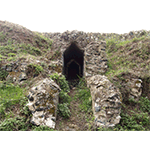
The Roman Age - The Eclipse of Elban Iron
During the Roman age, the Tyrrhenian mining district suffered the general crisis that involved the entire Italic mining industry. The competition of the Spanish and Norico mines led to thinning out production, the definitive cessation of which was probably established by a law recorded by Pliny the Elder (Nat. Hist. III, 20, 138; XXXIII, 21, 78). A confirmation of the progressive dismantlement of the siderurgical activity of Populonia is contained in the description of the geographer Strabo who lived in the Augustan age, and visited an impoverished city whose mines, scattered throughout the area, seemed long deserted to him (Geog. V, 2, 7). In this period, the territory indeed knew a different exploitation, centred on agricultural activity: evidence of this are the ruins of numerous villas visible on the islands of the archipelago (for example, Villa of the Grottoes at Portoferraio) and along the coast. The situation must not have substantially changed in the course of the Empire: when traveller Rutilius Namatianus reached Populonia in the winter of 417 A.D., he found a city that indeed seemed by then abandoned, where «the monuments of past epochs can no longer be recognised […] amidst collapses and ruins of walls lie roofs buried in vast ruins» (De reditu suo 399-414).
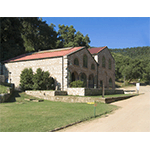
The Middle Ages - The Slow Rebirth
For almost five centuries, the Tyrrhenian mine fields lay practically unexploited. Only in concomitance with the progressive reoccupation of the territory, which began as of the 10th century, did the hypothesis re-emerge to exploit the ancient fields. The medieval village of Rocca San Silvestro is an exemplary case, as it makes it possible to go back over the history of this new golden age in the mining activity of Tuscany (10th – 14th century). The lead mines of the Metalliferous Hills, which also yielded copper and silver, were the cause of a harsh dispute among the Communes of the area. It was precisely from the control of these mines that Pisa for centuries drew the precious metal with which the coins of the Republic were minted. Unlike those of the Etruscan age, usually characterised by narrow shafts, unlined internally, the mines of the Middle Ages are recognised for their wider and more distanced passages, often reinforced internally with facing in masonry or wood.
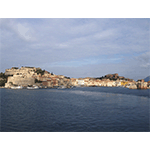
The Renaissance Age - Between Science and Profit
In the age of Rebirth, treatises on mining technology, the construction of machines, the fortification art, and hydraulics defined a new relationship between scientific knowledge and technical-artisanal knowledge, also thanks to the recovery of the great building tradition of the classical world. The remarkable technical capabilities and the ingeniousness of protagonists like Filippo Brunelleschi, Francesco di Giorgio and Leonardo da Vinci made significant contributions to the development of science and technology. A strong impulse to mining activities came from Cosimo I de’ Medici who in founding "Cosmopoli" (Portoferraio), a city born for military purposes, facilitated trading and transporting iron from the Elban mines to the processing plants of the Grand Duchy. Thanks to the renewed interest for the ancient mining areas of the Etruscan age, the exploitation of mines became even more systematic. An exemplary case is provided still today by the Temperino mine, a complex that combines underground passages of the Etruscan age to the wells of the Medicean age.
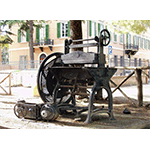
The Modern Age - The Formation of an Iron Industry
The phenomenon of the renewed exploitation of the Tuscan subsoil, rich in metals, did not come to a halt even in the following centuries. In the midst of the 18th century, after conducting studies on the territory, Giovanni Targioni Tozzetti indicated the recovery of several abandoned mines as one of the conditions for the economic recovery of the Grand Duchy. In the course of the 19th century, Leopold II attempted to relaunch the mining and extractive industry: several old copper, alum, lead, sulphur and mercury mines were thus reopened. It was, however, iron and its related industry that played an undisputed leading role throughout the entire 19th century. The protagonists were, in particular, the Elban mining districts which, as of 1815, became grand-ducal property. The first half of the 19th century witnessed the first examples of the use of iron in constructions, which laid the basis for a profitable relationship between art and industry. The new technology was also utilised in Florence where two suspension bridges (no longer existent) were built over the River Arno and called San Leopoldo and San Ferdinando in honour of the Lorraine grand dukes. Surviving constructions are instead the Porta San Marco in Livorno and the church of San Leopoldo in Follonica, the main iron centre of Lorraine Tuscany. These same years witnessed the birth of the grandiose complex of the foundry, which has been wonderfully renovated to serve, in part, as the venue of the Museum of Iron and Cast Iron.
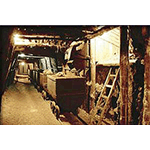
The Contemporary Age - The Decline of a Millenarian Economy
The years following the Unification of Italy did not mark a slackening of mining activity which, on the contrary, received new stimulus from the discovery of important metalliferous fields, such as the one in Gavorrano, the exploitation of which began in 1898 by initiative of the local inhabitants. The same period witnessed the birth of one of the most important mining industries in Italian history: Montecatini, successively better known as Montedison, whose historical parabola is well illustrated in the Mine Museum of Montecatini Val di Cecina.
It was only the fierce competition of the extra-European mining industry in the decades following World War II, that decreed the slow decline of the Tuscan metalliferous industry, evidence of which survives in the numerous museums and mining parks scattered throughout the territory. Among these, it is only right to cite the two mine museums of Massa Marittima, the Lignite Mines Documentation Centre of Cavriglia and, for its important mercury mining sector, the Mine Museum of Santa Fiora, which is part of the Monte Amiata Mining Park.
-
 Centro di Documentazione delle Miniere di Lignite - Museo delle Miniere [Lignite Mines Documentation Centre - Mine Museum]
Centro di Documentazione delle Miniere di Lignite - Museo delle Miniere [Lignite Mines Documentation Centre - Mine Museum] -
 Museo della Miniera [Mining Museum]
Museo della Miniera [Mining Museum] -
 Museo delle Miniere - Parco Minerario del Monte Amiata [Mine Museum - Mount Amiata Mining Park]
Museo delle Miniere - Parco Minerario del Monte Amiata [Mine Museum - Mount Amiata Mining Park] -
 Museo delle Miniere di Montecatini [Mine Museum of Montecatini]
Museo delle Miniere di Montecatini [Mine Museum of Montecatini] -
 Museo di Arte e Storia delle Miniere [Museum of Mining Art and History]
Museo di Arte e Storia delle Miniere [Museum of Mining Art and History] -
 Parco Minerario Naturalistico di Gavorrano [Gavorrano Natural Mining Park]
Parco Minerario Naturalistico di Gavorrano [Gavorrano Natural Mining Park]
****************************
Texts by Elena Fani
English translation by Victor Beard
Last update 19/gen/2008


